The Star Wars You've Never Seen
Jul 14, 2013
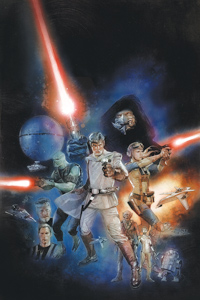 A pop culture phenomenon that has captivated audiences since 1977, Star Wars has become the high water mark by which all contemporary science fiction dramas can be judged. Its legacy is global, and its impact is incalculable. But Mark Hamill, Carrie Fisher, and Harrison Ford did not appear in a Hollywood drama that was George Lucas' first draft. The script had undergone several changes. And what Lucas had originally penned had remained in his personal archive...until today. Now, from Dark Horse Comics, Lucas' original vision titled The Star Wars (JUL130008) will be published as an 8-issue mini-series, written by J. W. Rinzler and illustrated by Mike Mayhew. Both men agreed to talk to PREVIEWSworld about the work that went into such a project, and how they've handled the responsibility of interpreting what some fans would call the "bible."
A pop culture phenomenon that has captivated audiences since 1977, Star Wars has become the high water mark by which all contemporary science fiction dramas can be judged. Its legacy is global, and its impact is incalculable. But Mark Hamill, Carrie Fisher, and Harrison Ford did not appear in a Hollywood drama that was George Lucas' first draft. The script had undergone several changes. And what Lucas had originally penned had remained in his personal archive...until today. Now, from Dark Horse Comics, Lucas' original vision titled The Star Wars (JUL130008) will be published as an 8-issue mini-series, written by J. W. Rinzler and illustrated by Mike Mayhew. Both men agreed to talk to PREVIEWSworld about the work that went into such a project, and how they've handled the responsibility of interpreting what some fans would call the "bible."
**********
PREVIEWSworld: John/Mike, given that this is an eight-issue mini-series, which is double the number of issues first used for the original 1970s Star Wars comic adaptation (4 issues), what new grounds are you covering that would account for such a lengthy project? Will this series only give us "A New Hope," or the ensuing chapters as well? Can we expect more character development? Sub-plots? Of course you can only give so much away, but fans are chomping at the bit for some details. So what can you tell us?
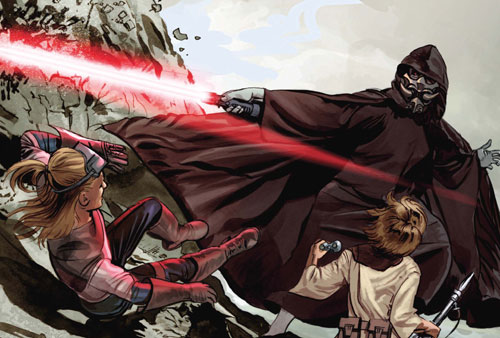 |
John W. Rinzler (JWR): Although the rough draft is about 180 pages long, typed, in some ways it's an outline, with certain scenes only sketched in while others are more fully developed. On screen, if they had filmed it, The Star Wars would've been more than three hours long — probably closer to four, or more — which is why we needed eight issues to get through the whole story. We considered six issues, but once I broke down the rough draft into panels, pages, and issues, it fit very naturally into eight issues.
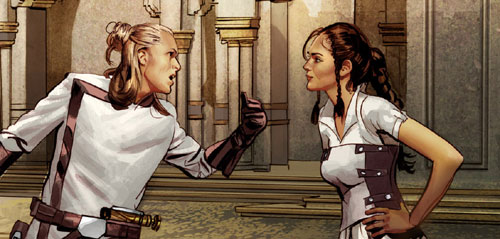 |
There aren't a lot of sub-plots. The story is pretty straight-ahead. One thing George has always favored and pioneered is telling multiple stories simultaneously, like in American Graffiti and the later Star Wars movies, but here, as in Episode IV, it's a little more streamlined, though you do have Leia going off, and a Sith doing his thing, and a secret agent, and rebels; but they wouldn't really count as sub-plots.
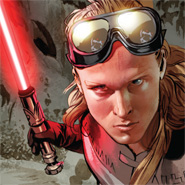 The whole story is, on the other hand, very dense, with many, many set, scene, and locale changes. Things that would've cost a fortune to build and then film are only used in one scene (which is one reason this was a rough draft; George knew it was physically impossible to film this version). But... we can do it in a comic book! Though even here it's been a huge, huge job for Mike to design and switch scenes sometimes several times for several pages in a row or more, as much as three times on a page. But it's going to be a lot of fun to read through, as a result.
The whole story is, on the other hand, very dense, with many, many set, scene, and locale changes. Things that would've cost a fortune to build and then film are only used in one scene (which is one reason this was a rough draft; George knew it was physically impossible to film this version). But... we can do it in a comic book! Though even here it's been a huge, huge job for Mike to design and switch scenes sometimes several times for several pages in a row or more, as much as three times on a page. But it's going to be a lot of fun to read through, as a result.
Mike Mayhew (MM): Eight issues is barely enough to contain this entire epic. The plot to this story is wildly different from Star Wars: A New Hope. It really has no connection in terms of the structure. Imagine if the action from all six movies happened to Luke, Obi-Wan, and Leia in Episode IV. That starts to give you an idea of how this story is so action packed and intricate.
The characters are very, very different. And, because of this the relationships are nothing like familiar Obi Wan/Luke, or Luke/Han, or Leia/Luke ones from Episode IV. Sometimes it's huge differences, like how our young hero Annikin is more advanced in his Jedi training and more of a barbarian than inexperienced and naïve farmboy Luke from Episode IV. Other times it's a simple twist like having R2D2 talk that changes his relationship with C3PO a lot, and makes it feel new.
 |
The all-new characters add to the story and do things that are unexpected. For instance, a new rebel agent Klieg Whitsun, teams up with General Luke and Annikin and he is key to their mission. Also, a new villain, one of the Sith 100, has some major character development and does something a villain has never done in a Star Wars film!
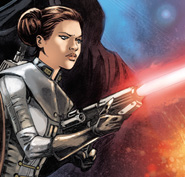 PREVIEWSworld: John, you're the person who will be giving us George Lucas' "bible": a story that grew to become a permanent fixture of international pop culture. Can you walk us through how you worked it out over at Lucasfilm to bring this project to fruition? Why is the project being released now? And how did you mentally prepare for such a task?
PREVIEWSworld: John, you're the person who will be giving us George Lucas' "bible": a story that grew to become a permanent fixture of international pop culture. Can you walk us through how you worked it out over at Lucasfilm to bring this project to fruition? Why is the project being released now? And how did you mentally prepare for such a task?
JWR: The process for bringing to life The Star Wars was not calculated. It came about because of the work I was doing while writing The Making of Star Wars. I read through all the drafts and was just amazed at how George evolved the story through several very different iterations before getting to a shooting script — which was still a work in progress (as they always are). And I thought the rough draft would, in particular, make a really cool comic book. I grew up reading the great Jack Kirby and Stan Lee stories, and this felt right in that tradition, while of course also being heavily inspired by Kurosawa's Hidden Fortress.
A few years later, I mentioned the comic book idea to George and he was dubious. But then a while after that I heard that Dark Horse and Randy Stradley had a similar idea. So we joined forces: I chose and adapted a few scenes I thought would appeal to George and an artist drew them up and colored them. And we didn't add in any word balloons because I know that George really likes to see if the story flows visually (and so do I)]
 |
George took a look, liked what he saw, and gave us the green-light. We were very happy. We knew it would be fun to do and I really think readers will agree. The first issue has a little more set-up than the following issues, so I hope readers will stick to it. Issue #2 already has a lot more action — an attack on the Space Fortress, the precursor to the Death Star.
Fortunately, Mike is doing a helluva job, and every panel is beautiful in issue #1 and #2 (the only ones I've seen so far). I think it's the best comic book I've read in years. And fans should really get a kick out of reading the very first Star Wars story that George ever wrote. It's a rare, rare opportunity.
 |
To prepare, I didn't really do anything in particular. I'm used to working in George's world; I've written about the behind-the-scenes, made up stories for fiction, and even written an Indiana Jones book for Scholastic. I understand, more or less, what each of his scenes is getting at and have seen him at work, up close, on set, at ILM, in the editing suite — we've talked about film, politics, art. I get it.
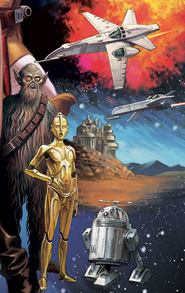 PREVIEWSworld: Mike, did you receive a Ralph McQuarrie archival collection of some sort that you used as the foundation for your drawings? Were his drawings the templates for your character sketches and vehicle designs? Or did you use additional references in drafting the designs for the ships and robots? If so, what were they?
PREVIEWSworld: Mike, did you receive a Ralph McQuarrie archival collection of some sort that you used as the foundation for your drawings? Were his drawings the templates for your character sketches and vehicle designs? Or did you use additional references in drafting the designs for the ships and robots? If so, what were they?
MM: Any and all pre-existing concept art was essential to our design approach. As much as possible, our team strived to make this as if George was filming the '74 script using the concept art he had at the time and shortly thereafter. Jonathan's exhaustive research work on The Making Of Star Wars, as well as my own volumes of Star Wars art books I had since childhood informed our design process. When there was no pre-existing art, Jonathan had access to a wealth of anecdotes and trivia that helped us connect the dots and design something in the spirit of where George and Co. were at circa 1975. To give you an idea of how thought-out things are there is a ring a character wears in #1 that records some intelligence info the rebels use. The signet on the ring is a Black Falcon, which was the name of George's licensing company he created before the first film!
Regarding Ralph McQuarrie, he is the "Jack Kirby" to this "Marvel Universe." I did my best to always keep that in mind. Our guiding light is the combination of his amazing design sense and virtuoso ability to make the most fantastical scene have a sense of verisimilitude.
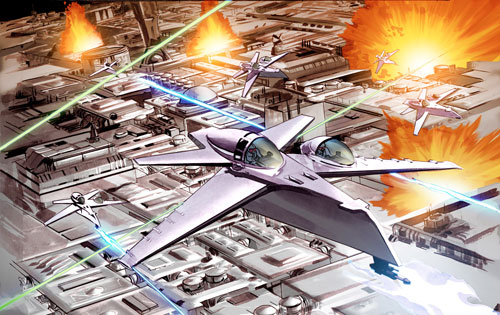 |
I also drew upon my experience as a child of the 70s. Before Star Wars came out when I was 7, I was reading Famous Monsters Of Filmland magazine, watching lots of sci-fi movies, and immersing myself in adventure stories. I grew up to be a student of late 60s and 70s filmmakers, and feel I have a very deep understanding of where George and his peers where coming from in terms of cinema and storytelling. I tried to put myself in the mindset of George's fellow filmmakers circa 1974, like John Boorman, or Francis Coppola, and John Milius. I always remembered the legends of divergent world cinema that influenced Star Wars like Fellini's Satryicon and Kurosawa's Hidden Fortress, and sought to represent that. I also love sci-fi art and comics, so the same things that were influencing George like John Berkey paperback covers or Alex Raymond’s Flash Gordon were things I could pull off my bookshelf and refer to.
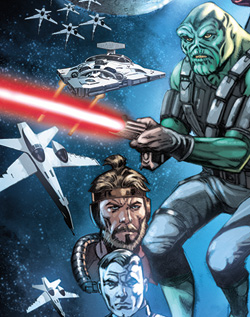 The most amazing thing to me as a Star Wars fan and aficionado was I really had no idea the extent to which some of these original characters and concepts were developed. In fact, they had almost been repressed, or at least mislabeled in the volumes I had over the years. I grew up thinking the proto-Jedi McQuarrie art were concepts of early Han or early Luke. I had no idea those images where actually to be General Luke Skywalker or Kane Starkiller. I can't tell you the shock and amazement I experienced when for the first time the pieces of the puzzle were made clear. It was a real eye-opening experience. When I felt that excitement and wonder it was like discovering Star Wars for the first time. That's when I realized what a huge hit this could be with both die-hard SW fans, but more importantly with wayward or non-Star Wars fans. You might not like Star Wars, but you can't deny how great this story is and the characters within.
The most amazing thing to me as a Star Wars fan and aficionado was I really had no idea the extent to which some of these original characters and concepts were developed. In fact, they had almost been repressed, or at least mislabeled in the volumes I had over the years. I grew up thinking the proto-Jedi McQuarrie art were concepts of early Han or early Luke. I had no idea those images where actually to be General Luke Skywalker or Kane Starkiller. I can't tell you the shock and amazement I experienced when for the first time the pieces of the puzzle were made clear. It was a real eye-opening experience. When I felt that excitement and wonder it was like discovering Star Wars for the first time. That's when I realized what a huge hit this could be with both die-hard SW fans, but more importantly with wayward or non-Star Wars fans. You might not like Star Wars, but you can't deny how great this story is and the characters within.
PREVIEWSworld: How did this project challenge the both of you creatively? What about it had you make multiple trips to the drawing board? What were you proving to yourself?
JWR: This is my first comic book, but fortunately Randy Stradley is overseeing it and pointing out things that would be obvious to more experienced comic book writers. But I've never stopped reading the format — I love Will Eisner above all — so it all feels pretty natural to me.
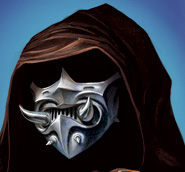 MM: Well...this is the challenge of my life. This is my Olympics. I've been training for 20 years as a professional comic artist for just this moment, and it’s demanding everything I have and more. In a very short amount of time, I have to present a visual package by myself (with the aid of my super-colorist Rain Beredo) that rivals what George spent 4 years making with an army of what would be some of the most influential technicians and artists in cinema history. It's a daunting task, but the opportunity of a lifetime. It’s a blessing to have this challenge at this stage in my life, and I'm pouring everything I have into making this as big as it deserves to be.
MM: Well...this is the challenge of my life. This is my Olympics. I've been training for 20 years as a professional comic artist for just this moment, and it’s demanding everything I have and more. In a very short amount of time, I have to present a visual package by myself (with the aid of my super-colorist Rain Beredo) that rivals what George spent 4 years making with an army of what would be some of the most influential technicians and artists in cinema history. It's a daunting task, but the opportunity of a lifetime. It’s a blessing to have this challenge at this stage in my life, and I'm pouring everything I have into making this as big as it deserves to be.
PREVIEWSworld: How has this series affected your perspective on the Star Wars universe? As The Clone Wars has allowed fans to see Anakin Skywalker as a hero, do you think other characters will now also be seen in a new light? And can the events/translation of this series possibly open doors for future developments of Lucas' legacy?
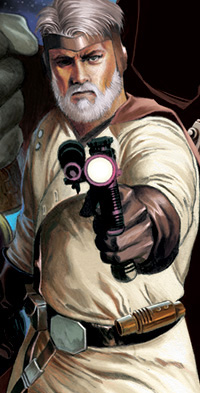 JWR: Who knows! There are other scripts — particularly for Return of the Jedi — that would benefit from being told in comic book form. But these characters in The Star Wars are not the same characters as in the films. General Luke Skywalker, Count Sandage, Jedi Annikin Starkiller, Clieg Whitsun, Biggs and Windy — these are prototypes for later development. They follow a different story arc; it's like an early version of a film or a painting that was later re-done by the same master. The earlier version gives you great insight into how his mind was working and maybe shows some material in a wholly different or more light-hearted way.
JWR: Who knows! There are other scripts — particularly for Return of the Jedi — that would benefit from being told in comic book form. But these characters in The Star Wars are not the same characters as in the films. General Luke Skywalker, Count Sandage, Jedi Annikin Starkiller, Clieg Whitsun, Biggs and Windy — these are prototypes for later development. They follow a different story arc; it's like an early version of a film or a painting that was later re-done by the same master. The earlier version gives you great insight into how his mind was working and maybe shows some material in a wholly different or more light-hearted way.
MM: I think the analogy that gives some insight into what it's like to be in the middle of this project is this: imagine that they uncovered lost master tapes of an early version of what would become Sgt. Pepper's Lonely Hearts Club Band. No one has ever heard them. Most of the songs are completely different from what ended up on the album. Even the familiar ones have differences, yet are equally as good as the originals. Your job? Record those songs and present them to the world. That's the position I'm in. Does having to do that expand my perspective on the Star Wars universe? More than you could ever know.
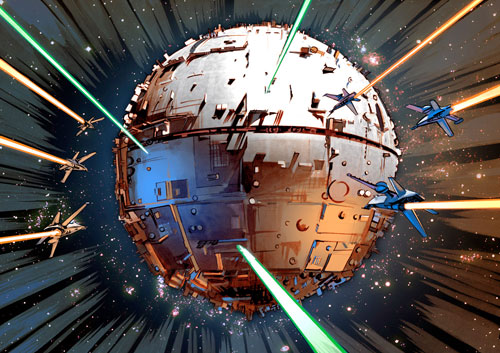 |




